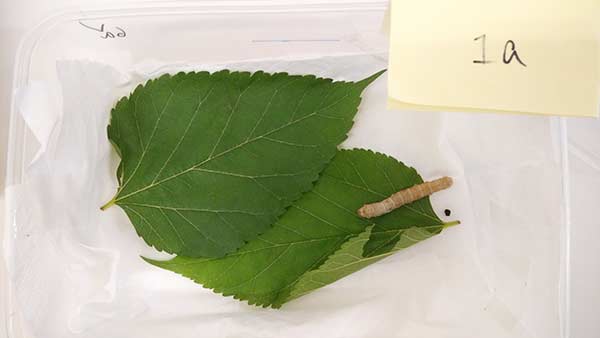
A larva prepared for the experiment by the students from Hong Kong.
The student team explained that the excrement had to be cleaned up frequently because close contact with germs could have endangered the larvae during their days in space.
The original idea was to use an electric fan to suck away the waste product, but the astronauts tweaked the approach to save themselves time and energy. In a video shot onboard Tiangong II and released by Xinhua News Agency, Chen can be seen unscrewing the top of a capsule and shaking out black bits of feces that then drifted up into a plastic bag.
In the same video, Jing, the mission commander, was seen drifting weightlessly and carrying a pocket-size capsule that held one of the six larvae.
Through the windows of the six capsules, he observed and assessed how the larvae reacted and grew in space. "Look. The device is the home of the larvae," he said. "And in fact, they are now in their second home, which is the Tiangong II space lab, 393 kilometers above the Earth."
The experiment was one of three projects jointly designed by mainland space engineers and the Hong Kong students. Their endeavors were to become part of China's longest manned space mission.
The six larvae aboard Shenzhou XI were sent into space on Oct 17. The day before the launch, Wu Ping, deputy director of China's manned space engineering office, told a media briefing that the tasks undertaken during the 33-day mission, including the silkworm experiment, would be "engrossing" and "well worth seeing".
Triumph
The larvae fulfilled the hopes of the students and the mission scientists, as five of the six succeeded in spinning cocoons. The experiment was a triumph for all involved.
"Aerospace experiments were something very farfetched, they used to be a visionary dream to students in Hong Kong," said Mak Tang Pik-yee, executive director of the Hong Kong Productivity Council, who was a member of the organizing committee of the 2015 Space Science Experiment Design Competition.
However, the astronauts carried through the students' dreams, sending their designs from Earth into space, she added.
The larvae were frozen following their return to Earth on Nov 18. They will remain dormant in low-temperature conditions while the groundwork is laid for follow-up experiments into the effects of microgravity on spun silk.
"There was a time when we would never have anticipated that the students' ideas could be brought into space," said Chow Wing-hei, teacher and project adviser of the silkworm experiment. "But we're all now basking in the glory of having those ideas tested and proven successful in space."


















































